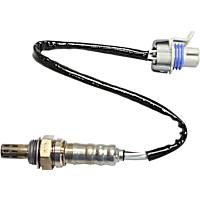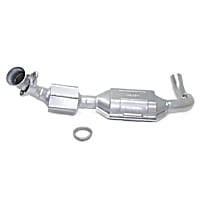Poor fuel economy, a failed emissions test, and engine problems—these are symptoms that a lot of automotive issues share. Run your OBD-II scanner to narrow down the problem. If it indicates a P0134 code, address it immediately with this guide to keep your car in top condition.
What Does the P0134 Code Mean?
Diagnostic trouble code (DTC) P0134 stands for “Oxygen Sensor Circuit No Activity Detected (Bank 1, Sensor 1).” The code indicates that your car’s primary computer, which is often referred to as the powertrain control module (PCM), has detected inactivity from the upstream oxygen sensor (O2) on Bank 1. This usually points to an inoperative O2 sensor heater.

To learn why O2 sensors need to be heated, you may read our explanation here.
The Bank 1 portion of the code refers to the side of the engine with the number one cylinder. Sensor 1 refers to the upstream O2 sensor.
Heated O2 sensors have four wires, and two of those wires are always the same color, sometimes white, sometimes brown. Those are the two heater wires; one will typically receive voltage with the key on (through a relay) and the other is the ground, controlled by the ECM/PCM. If the circuit opens within the ECM/PCM, or at a connector, or if either wire is severed or shorted, the P0134 may be stored.
Note that the P0134 code doesn’t appear on many vehicles, and even on the vehicles where it does appear, the code doesn’t always mean the same thing.
For example, on a 2018 Honda Accord, the P0134 specifically means the O2 Heater in Bank 1 Sensor 1 has malfunctioned. Of course, if the heater goes dark due to an open circuit or a bad heater in the sensor, the sensor may stop producing voltage. The ceramic zirconia must maintain 600°F in order to produce the voltage it sends to the ECM/PCM.
Note: Although code P0134 is a generic code specified by the Society of Automotive Engineers (SAE), the code’s definition may be different depending on the vehicle manufacturer.

What Does an Oxygen Sensor Do?
O2 sensors keep track of the amount of oxygen in the exhaust. There is an upstream O2 sensor (the sensor before the catalytic converter) and a downstream sensor (located after the catalytic converter). The upstream sensor is referred to as sensor 1, and the downstream sensor is sensor 2.
The PCM uses the signal from the upstream sensor to calculate fuel control and the signal from the downstream sensor to determine the efficiency of the catalytic converter.
All modern oxygen sensors are heated oxygen sensors (HO2S). That means each sensor has a heating element that the PCM activates to bring the sensor up to operating temperature.
The PCM ignores the signal from the O2 sensor until the sensor is warmed up.
The PCM keeps track of the time it takes for an oxygen sensor to warm up. If the sensor takes longer than the PCM expects (or the sensor is not responsive), the module considers the sensor as inactive or open. It’ll then turn on the check engine light and store diagnostic trouble code P0134 in its memory.
What are the Possible Causes of the P0134 Code?
The most common issues that can trigger the code P0134 include:
- Bad or failing O2 sensor and/or the heater in that sensor
- Problems with the O2 sensor circuit (wires, connectors, or the sensor itself)
- Issues with the PCM itself

These issues are not mutually exclusive.
What are the Common Symptoms of the P0134 Code?
A problem with the upstream oxygen sensor or its control circuit can cause several problems. Some of the most common symptoms include:
- Illuminated check engine light
- Engine performance problems (e.g., misfiring, hesitation, rough idle, and lack of acceleration)
- Poor fuel economy
- Failed emissions test
- No symptoms at all
Note: If there are other codes stored in addition to P0134, the code’s common causes and symptoms may differ from those listed here.
How to Diagnose the P0134 Code
If your scan tool or code reader reports a P0134 code or another trouble code regarding the oxygen sensors, your first impulse would probably be to replace the sensor.
While a faulty sensor often proves to be the culprit, it’s a good idea to perform some troubleshooting beforehand to make sure.
Here are a couple of videos to help give you an idea of the diagnostic process:
How to Fix the P0134 Code
As previously mentioned, replacing the affected oxygen sensor will usually fix a code P0134—but not always. There are many problems that can potentially trigger the code. What’s more, vehicles are often engineered differently based on their make and model. This means they may require a specific diagnostic process.
That’s why, before attempting to fix the code, you need to consult the factory repair information for your application.
Not sure if your automotive know-how is enough to address the issue? Use repair manuals, such as those from Chilton, to expand your knowledge—or invest in an ALLDATA subscription.
ALLDATA has single-vehicle subscriptions for DIYers that provide detailed factory repair information.
Where to Get an Oxygen Sensor Replacement for Your Vehicle
If your vehicle logged a P0134 code, it might only be a matter of time before you experience issues like rough idling or low fuel economy. A faulty oxygen sensor is usually the culprit. If you’ve confirmed that to be the case with your ride, it’s time to get the ball rolling on the repairs. Shop for an oxygen sensor replacement at CarParts.com.
We guarantee that you’ll get an oxygen sensor that’s built to last. After all, we source our sensors from top aftermarket brands and our industry experts carefully handpicked each one.
Our website makes it easy for car owners like you to find the right parts for your ride. After using our vehicle selector to view compatible oxygen sensors, you can change the filters to find the ones that match your needs.
What’s more, we have warehouses strategically located across the country. That means it wouldn’t take long before your orders arrive. If you have questions about a product, you can reach us using our toll-free hotlines, and a customer service representative will be glad to answer your queries.
Make your vehicle’s maintenance a priority. Order your oxygen sensor replacement now!
Products Mentioned in this Guide
Shop this Project



Any information provided on this Website is for informational purposes only and is not intended to replace consultation with a professional mechanic. The accuracy and timeliness of the information may change from the time of publication.


 Oxygen Sensor
Oxygen Sensor
 Catalytic Converter
Catalytic Converter





















